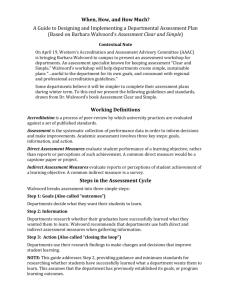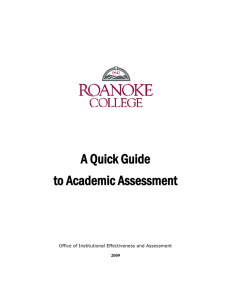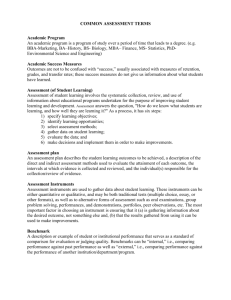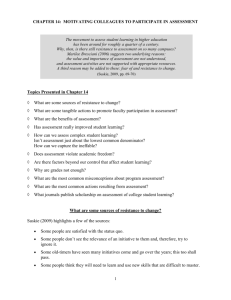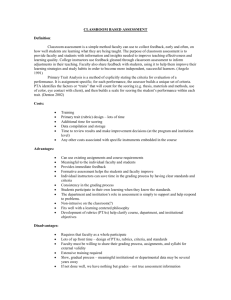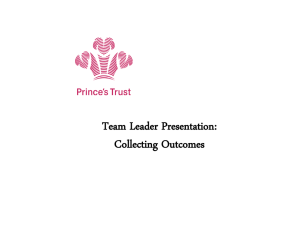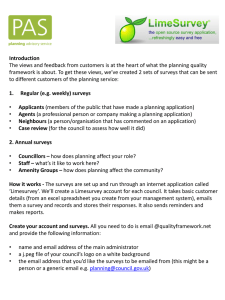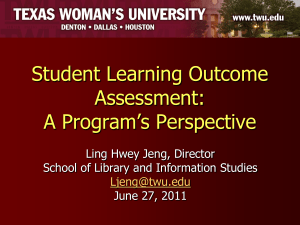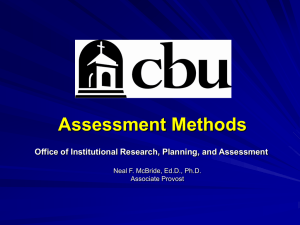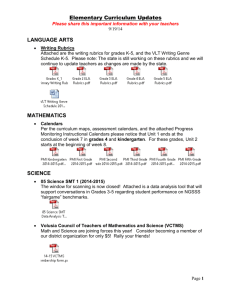Assessing Student Learning in STEM Departments or Programs
advertisement
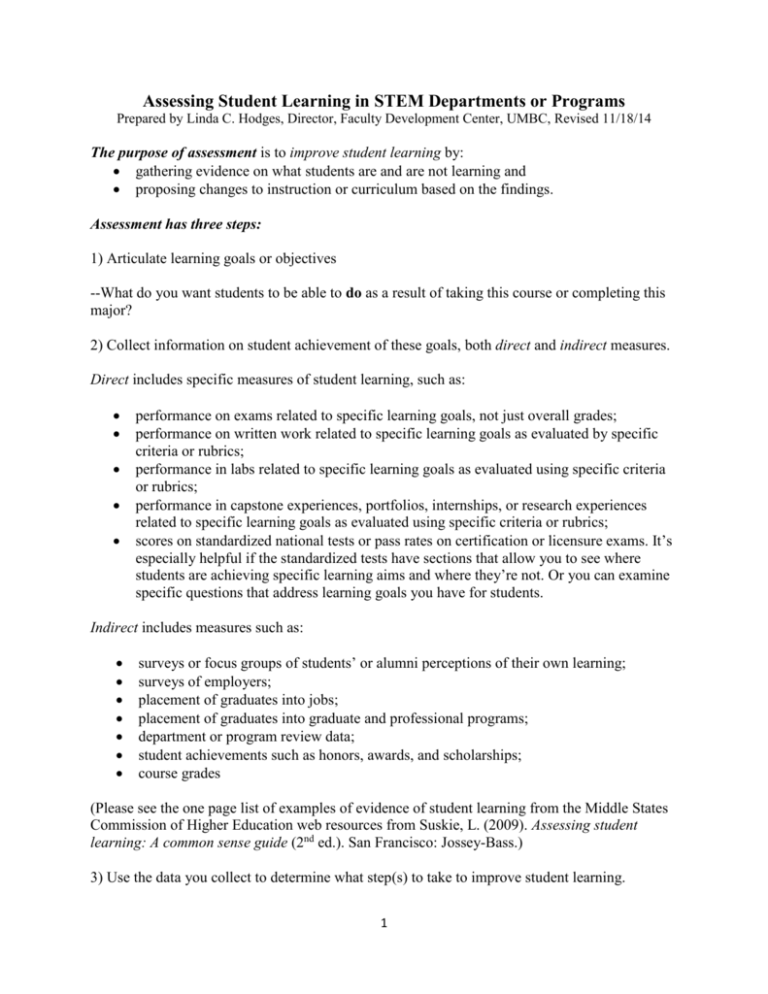
Assessing Student Learning in STEM Departments or Programs Prepared by Linda C. Hodges, Director, Faculty Development Center, UMBC, Revised 11/18/14 The purpose of assessment is to improve student learning by: gathering evidence on what students are and are not learning and proposing changes to instruction or curriculum based on the findings. Assessment has three steps: 1) Articulate learning goals or objectives --What do you want students to be able to do as a result of taking this course or completing this major? 2) Collect information on student achievement of these goals, both direct and indirect measures. Direct includes specific measures of student learning, such as: performance on exams related to specific learning goals, not just overall grades; performance on written work related to specific learning goals as evaluated by specific criteria or rubrics; performance in labs related to specific learning goals as evaluated using specific criteria or rubrics; performance in capstone experiences, portfolios, internships, or research experiences related to specific learning goals as evaluated using specific criteria or rubrics; scores on standardized national tests or pass rates on certification or licensure exams. It’s especially helpful if the standardized tests have sections that allow you to see where students are achieving specific learning aims and where they’re not. Or you can examine specific questions that address learning goals you have for students. Indirect includes measures such as: surveys or focus groups of students’ or alumni perceptions of their own learning; surveys of employers; placement of graduates into jobs; placement of graduates into graduate and professional programs; department or program review data; student achievements such as honors, awards, and scholarships; course grades (Please see the one page list of examples of evidence of student learning from the Middle States Commission of Higher Education web resources from Suskie, L. (2009). Assessing student learning: A common sense guide (2nd ed.). San Francisco: Jossey-Bass.) 3) Use the data you collect to determine what step(s) to take to improve student learning. 1 A Simple Department Assessment Plan 1) Articulate department or program learning goals—what should your students be able to do as a result of completing your program? 2) Collect data on student achievement of department or program learning goals, at least one direct measure, one indirect for each goal. Assessment measures may be embedded in existing courses or coursework (see page 4-5) or may be add-on measures. Decide on what measures to use based on the usefulness of the information they provide and how doable they are. 3) Hold an annual meeting to analyze the data and decide what key issues to address, no more than 1-3, based on department priorities and feasibility of addressing any particular issue. Assign responsibility for follow up. 4) Report results using a simple grid-like template (see below). Assessment Strategies to Considerǂ If you want to… Consider using… Assess thinking and performance skills Assignments planned and evaluated using scoring guides or rubrics Assess knowledge, conceptual understanding, or skill in application or analysis Multiple choice tests or embedded questions Assess attitudes, values, dispositions, or habits of mind Reflective writing, surveys, focus groups or interviews scored with criteria Draw an overall picture of student learning Portfolios using scoring guides or rubrics Compare your students against peers elsewhere Published tests or surveys ǂFrom Suskie, L. (2009). Assessing student learning: A common sense guide (2nd ed.). San Francisco: Jossey-Bass, p. 34. 2 Example of Using the Data to Propose Changes As part of the senior capstone course in ________________, Professor Smith asked her students to interpret data from scientific research papers, a skill which relates to a program-wide learning goal. She has questions embedded on exams related to this skill as well as questions asking students to demonstrate certain content knowledge, another program-level goal. During the annual meeting discussion, she shares her composite exam data. The data indicate that students scored well on specific questions on content from the scientific papers, showing that the program goal of demonstrating certain content knowledge was being achieved. At this point participants applaud. More than half of the students performed poorly, however, on those questions related to interpreting data in tables and graphs. The department checks the program curriculum grid to see in what courses this skill is addressed. Although students are exposed to data interpretation in several courses, the faculty realize that students are given very little chance to practice this skill. Given the content load in the lowerdivision courses, however, faculty are reluctant to devote much more time to data analysis in those courses. The department decides that the capstone course is the most logical class to concentrate on this skill. They propose having a brown bag lunch to discuss ways to engage students most effectively in learning skills related to data interpretation. Professor Smith and other faculty who will be teaching the capstone course volunteer to gather information by checking for on-line resources and talking to the Director of the Teaching and Learning Center prior to the brown bag. In this example, the focus for thinking about change was on curricular and pedagogical approaches, not on evaluation of the instructor’s teaching. As Barbara Walvoord emphasizes, assessment data are NOT used for personnel decisions. Assessment is a team effort with a shared goal of improved student learning. To keep assessment data separate from evaluation of faculty, some assessment measures or tools may need to be evaluated by outside reviewers. This process may be especially important for indirect measures such as student surveys or student focus groups. It is also best NOT to use student evaluation data for program assessment unless an aggregate of the entire department results is used. Other suggestions: --Groups, such as course coordinators, may collect and analyze data prior to the annual meeting and present summaries. --Outside agencies or consultants may be used to collect and/or analyze data. --Data sampling may include all students or a representative sample. Examples of Departmental Reports Sample department assessment reports can be found on the web or in Walvoord, B. (2010) Assessment clear and simple (2nd ed.). San Francisco: Jossey-Bass. 3 Collecting Data from Courses for Use in the Department Assessment Plan For each program goal, identify appropriate courses or experiences that will address the student learning outcome. You may wish to include this information on a grid for convenience (curriculum mapping). This grid can show you how often in the curriculum important learning goals are addressed. Then find ways to collect data specific to these outcomes for each course or experience. One measure must be a direct determination of student learning. In some cases you may use samples of student work, not all students’ work. Direct Measures Evaluation of student performance on exam questions that are specifically related to the learning outcome Evaluation of student performance on written work, lab reports, oral presentations, or poster presentations that are specifically related to the learning outcome using a rubric or set of criteria Observation of student work in internships or research experiences related to a specific goal and scored by a rubric or set of criteria Evaluation of student performance on a department exam, standardized exam, or peerreviewed concept inventory (best if administered as part of some course) Pre- and post-exam questions At the end of a course in which a program goal is assessed, an instructor evaluates the success of the teaching approach for meeting the goals identified.* Learning Outcome #1 (from program list) Learning Outcome #2 etc. How was learning outcome assessed? How well did students achieve the goal—strengths and weaknesses? Proposed changes (if appropriate) to improve student achievement of goal * Adapted from materials supplied by Barbara Walvoord 4 Proposed departmental changes needed to help students achieve this learning goal Indirect Measures Course grades Overall exam grades Student satisfaction or attitude surveys Student surveys of their perception of their own learning and skills (example below) For an indirect measure such as student surveys or focus groups, Walvoord suggests asking students three questions (I have adapted her questions for course level assessment to be appropriate for department level assessment as well): Indirect Measure: Example of Student Survey or Focus Group Questions* 1. How well did you achieve each of the course (program) learning goals [list them].(you could use a rating scale for responses) 2. What aspects of the course (or what courses) most helped you achieve the goals? (you could use a list of aspects of the course or of courses with a rating scale) OR You may more generally ask “What aspects of your education in this course (program) helped you with your learning, and why were they helpful?” Walvoord, p. 60 3. What suggestions do you have for actions that would help you learn more effectively? a) course structure(s) and content b) pedagogical approaches c) your own actions Because students will often equate course with professor, these surveys should be reviewed by a neutral third party who removes all references to specific instructors. Likewise, focus groups may need to be conducted by a neutral party. 5
